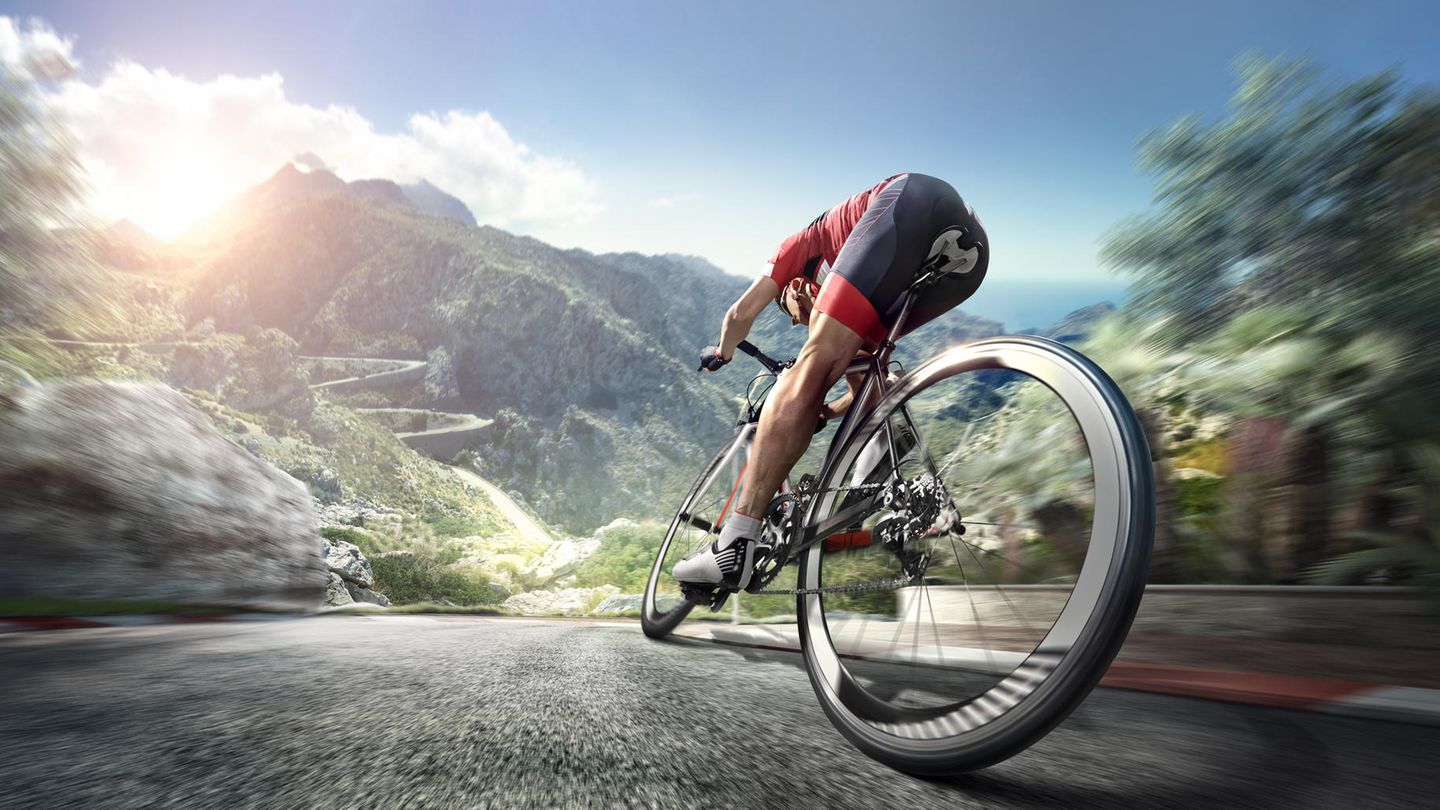A power meter for racing bikes measures how much pressure cyclists put on the pedals. The guide explains how power meters work, for whom they are worthwhile and which models are available.
For a long time, so-called power meters or watt meters were withheld from cycling professionals, which was due to the very high costs of the devices. In the meantime, they have become more affordable, which is why ambitious hobby cyclists are also interested in the power meters. The purpose of the watt meter is to accurately log the training progress in order to be able to better control your own training.
What does a power meter do?
A power meter or wattmeter calculates how much power cyclists exert when they pedal. In order to determine the performance of the cyclist, a power meter measures the material deformation in the pedal, crank arm or crank and sets it in relation to the cadence. Accordingly, there are three different types of wattmeters for racing bikes:
- in the crank arm
- in the pedals
- or on the chainring
They all work in the same way at the core and differ simply in where exactly the material deformation is measured. The power meter then forwards the determined data to an output device, such as a smartphone, via Bluetooth or other wireless data transmission.
Watt meter racing bike: Does that make sense?
Power meters measure data and pass it on. This is of course all well and good, but it is of no use if this data is not evaluated. A power meter only makes sense if you want to control your training specifically based on performance data.
There are several ways to train based on data. You can log the average speeds of your training sessions. Or you can time your time for the same distance or record your pulse with a heart rate sensor and use this to draw conclusions about your training progress. So why the watt measurement?
Because the power meter data is independent of external factors. Your speed on the bike, for example, is heavily dependent on tailwinds or headwinds, and our heart rate is also at least partially depressed or driven up by parameters that cannot be influenced, such as the weather. In addition, heart rate monitors always react with a delay to changes in load. After speeding up or climbing a mountain, it usually takes a few seconds for the higher heart rate to be displayed. A power meter reacts faster at this point and is therefore also better suited to controlling the cycling training.
Ideally, you should therefore combine your training data, i.e. measure pulse, wattage, speed and set the data as a function, for example to take into account your daily form during training.
Watt meter road bike: crank arm
Let’s start with the crank arm power meter because, together with the pedal power meter, it is the easiest and cheapest entry into the world of power meters for road bikes. Simply because installation is just as simple as with pedal systems and inexpensive because only one crank arm is required.
Crank arm systems usually only measure one-sided, i.e. only the pressure of one leg, which is then multiplied by a factor of two. Although a round and balanced kick of both legs is recommended when cycling, in reality this is hardly possible because most people’s legs have different strengths, which is why the measurement result of a one-sided power meter is usually a little less precise than that of both sides.
The fluctuations between the right and left leg mentioned are between 4 and 6 percent for most people. The resulting measurement inaccuracies are manageable for amateur athletes, especially when you consider that crank arm power meters are usually cheaper than pedal systems. Logical: Of course, before you buy, pay attention to the length of the right crank on the chainring and buy the same length power meter for the other side.
Watt meter road bike: Shimano 4iii Precision 3
A recommended introduction to the power meter for racing bikes is the . According to the manufacturer, its button battery lasts 800 hours before it needs to be replaced. In addition to the wattage from zero to 4,000 watts, the power meter also measures the cadence of the cyclist from 30 to 170 cadences per minute. The 4iii Precision communicates with the bike computer or mobile phone via Bluetooth. Compatible apps are, for example, Zwift, TrainerRoad and SYSTM, with which you can log your training exactly and evaluate it later.
pedal systems
With power meters in the pedal, you usually have to save the length of the crank arm once, because a longer crank arm results in a longer circumference that cyclists cover when pedaling. If you enter the wrong length there, the result will be falsified. This step is not necessary for power meters that are located in the crank arm or on the chainring.
You should also pay attention to the screw-in depth of the pedal axle with pedal systems. Logical: The smaller it is, the less material deformation is, and the longer it is, the greater material deformation is. Here, too, it is important to pay close attention to the manufacturer’s information, otherwise the measurement results could be falsified.
In addition, the pedals are one of the most exposed components on a bicycle. An unfortunate fall and the expensive power meter is gone. Power meters on the chain ring or in the crank arm are a little better protected against accidents.
Pedal power meters offer a practical advantage over the one-sided crank arm: they are even easier to assemble. This should be of particular interest to owners of several bikes who do not want to buy several power meters and are interested in changing power meters quickly. The pedals are easy to turn off and on again.
As far as the measurement is concerned, most pedal systems also work on one side. The one-sided pedal power meters are priced at the same level as the crank arm systems. Pedal power meters on both sides cost around 800 euros and more.
Watt meter road bike: Garmin Rally
An example of a double-sided pedal power meter is the which is available in different versions:
- Garmin Rally XC 100/200
- Garmin Rally RS 100/200
- Garmin Rally RK 100/200
It looks cryptic at first, but it’s simple. The 100 or 200 tell us whether the power meter is in one or in two pedals. Logical: 100 stands for single and 200 for double. XC, RS and RK provide information about the click system of the pedals. The pedals for road bikes and gravel or mountain bikes often differ in the click system.
- Garmin Rally XC stands for the Shimano SPD mount (gravel and mountain bike)
- Garmin Rally RS stands for Shimano SPD-SL-Mount (racing bike)
- Garmin Rally RK stands for the Look-KEO mount (racing bike)
Nice: Anyone who rides both a mountain bike and a racing bike will be happy to fit the power meter in the different pedals because the measuring instrument is located in the pedal axle. And you can mount this pedal axis in the different Garmin pedals. The conversion takes between ten to 15 minutes and requires not only the right tools but also some manual skills.
Otherwise, the Garmin power meter gets along very well with the in-house bike computers. But it can also work with other bike computers. According to the manufacturer, the integrated battery lasts up to 120 hours, but it is definitely special. It is a CR1/3N or LR44/SR44. Here it is worth buying the batteries in advance.
Watt meter on the chainring
Power meters, which are located on the chainring, usually measure the power of the left and right leg. However, their assembly is very complex because not every power meter can simply be screwed onto the old chainring, which is why you usually have to buy and install the chainring, crank arms and power meter from one manufacturer.
That also means removing the old crank axle, the crank arms and the chain ring and then installing the new equipment with a power meter. This can be a tedious task for beginners or inexperienced screwdrivers. And then the power meter is also limited to one bike, quick changes like with the pedals are not possible.
Watt meter road bike: Sram KRG Red AXS D1 Quarq Dub
The market leaders in chainring power meters are Quarq wattmeters in conjunction with SRAM chainrings. The manufacturer’s models also include the which comes in different versions in terms of crank arm length and chainring size.
With a price of 1120 euros, it is one of the most expensive power meters in comparison, which is also due to the fact that the package includes a crankset. If you know a suitable chain ring and crank arms are installed on your bike, you can save the money and buy the power meter separately.
Otherwise, the power meter measures the power of both legs and works with many bike computers thanks to Bluetooth or ANT+. If you already have a bike computer, you should of course check beforehand whether the power meter is compatible with it.
Measure training progress: FTP value
In order to recognize the training progress, athletes like to use the so-called FTP value. This can be determined particularly well with power meters because their data is independent of external factors. FTP stands for “Functional Threshhold Power”, which literally means “functional threshold power”. This threshold power (FTP value) represents what power a cyclist can just maintain over a time window of 60 minutes.
So at 100 percent FTP, we can cycle for exactly one hour. Cycling becomes 80 percent of our FTP value, we can ride longer. And if we drive above our means (at 150 percent, for example), the speed can only be maintained for a short time. So if we start our training with the power meter, it makes sense to determine the FTP value first, then train and repeat the same test again a month later. If the result improves, we can see relatively precisely by what percentage we have increased our performance.
How to determine the FTP value
Determining the FTP value is relatively easy in theory. Either, ride as fast as you can for 20 minutes, average the power meter reading and multiply by 0.95. Or you can simply cycle for 60 minutes at your best and calculate the average from the power meter data. Test routes that remain the same or, ideally, a roller trainer are ideal for both methods so that you are not exposed to external factors such as traffic or weather conditions.
Sources:
Source: Stern
I am Pierce Boyd, a driven and ambitious professional working in the news industry. I have been writing for 24 Hours Worlds for over five years, specializing in sports section coverage. During my tenure at the publication, I have built an impressive portfolio of articles that has earned me a reputation as an experienced journalist and content creator.




